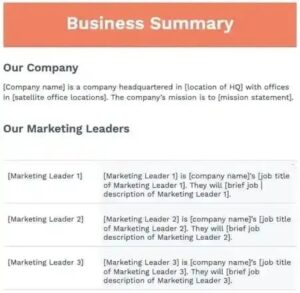Introduction
As a student, understanding how to create a marketing plan is crucial – whether you’re working on class projects, preparing for internships, or planning to launch your own business. This guide will walk you through the essential components of a marketing plan in clear, practical terms.
What Should a Marketing Plan Include?
A marketing plan is a roadmap that businesses like yours use to organize, execute, and track their marketing strategy over a given period.
-
Business Summary
Think of this as the “who we are” section. It includes:
- Company/Project name
- Location
- Mission statement (what you’re trying to achieve)
- Team members and their roles
Student Tip: For class projects, include your team members and their responsibilities. For personal projects, outline your own role and any collaborators.
-
SWOT Analysis
Your marketing plan’s business summary should also include a SWOT analysis.This summarizes your business’s strengths, weaknesses, opportunities, and threats (SWOT).
This is your opportunity to analyze four key areas:
- Strengths: What advantages do you have?
- Weaknesses: Where could you improve?
- Opportunities: What external factors could help you?
- Threats: What external factors could harm your success?
To become truly accurate, it requires thorough market research, data analysis, and competitive analysis.
Student Tip: Research similar projects or businesses to get realistic insights for your SWOT analysis. Use academic databases and industry reports available through your university library.
-
Business Initiatives
This section outlines specific marketing projects you’ll undertake. For example:
- Launching a social media campaign
- Creating content for your blog
- Organizing campus events
Every initiative should follow the SMART framework:
- Specific: What exactly will you do?
- Measurable: How will you measure success?
- Attainable: Can you realistically achieve this?
- Relevant: Does it align with your goals?
- Time-bound: When will you complete it?
For example, a broad goal might be, “Increase my Facebook following.” But a SMART version could be, “Increase my Facebook following by 30% by June.”
-
Target Market
Define who you’re trying to reach: A buyer persona is a semi-fictional description of your ideal customer. It focuses on traits like:
- Demographics (age, location, interests)
- Behavior patterns
- Needs and pain points
- Where they spend their time (online and offline)
Student Tip: For campus-based projects, consider surveying fellow students to gather real data about your target market.
-
Competitive Analysis
Research your competition by examining: A competitive analysis will detail the companies or brands you’re up against, which should be considered in your marketing strategies.
- Who are your main competitors?
- What do they do well?
- Where are their weaknesses?
- How can you differentiate yourself?
Student Tip: Don’t just look at direct competitors. Consider indirect competitors who solve the same problem differently.
-
Market Strategy
This section uses the “Seven Ps of Marketing”: ( or the “extended marketing mix“)
- Product: What are you offering?
- Price: How much will it cost?
- Place: Where will people find it?
- Promotion: How will you spread the word?
- People: Who’s involved in delivery?
- Process: How will you deliver it?
- Physical Evidence: What tangible elements prove your value?
How to Create Your Marketing Plan
Step-by-Step Process
- Research Phase
- Gather market data
- Survey potential customers
- Analyze competitors
- Review similar successful projects
- Define Your Audience
- Create detailed persona profiles
- Identify their needs and challenges
- Understand their behavior patterns
- Map their decision-making process
- Set SMART Goals
- Make them specific to your project
- Ensure you can measure progress
- Keep them achievable with your resources
- Set realistic timeframes
- Choose Your Tactics
- Select marketing channels
- Plan content strategy
- Determine promotional activities
- Schedule key activities
- Create Your Budget
- List all expected expenses
- Research cost-effective alternatives
- Include a contingency fund
- Track all spending
- Document Everything
- Use clear, organized formatting
- Include visual elements
- Keep it professional
- Make it easy to update
Timeline Management
Create a schedule that accounts for:
- Academic calendar
- Project milestones
- Team member availability
- Campus events and holidays
Student Tip: Use project management tools to keep your team coordinated and on track.
Measuring Success
Define metrics that matter:
- Engagement rates
- Conversion rates
- Website traffic
- Social media growth
- Event attendance
- Sales or sign-ups
Resources and Tools
Free Tools for Students
- Social media management: Buffer, Hootsuite (free plans)
- Design: Canva, GIMP
- Analytics: Google Analytics, Social media insights
- Project management: Trello, Asana
- Dowload now: Free Marketing Plan Templates
University Resources
- Marketing department resources
- Library databases
- Career center support
- Student organization partnerships
Conclusion
Remember that your marketing plan is a living document – review and update it regularly based on what’s working and what isn’t. Use this guide as a framework, but don’t be afraid to adapt it to your specific needs and project requirements.








